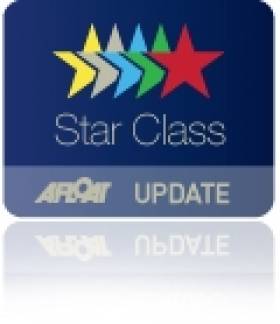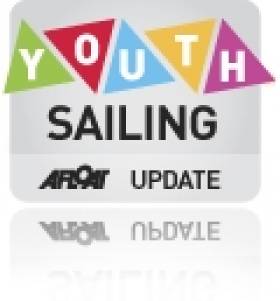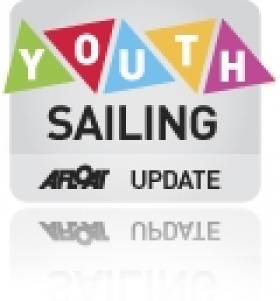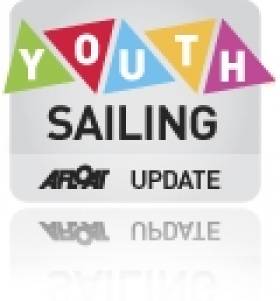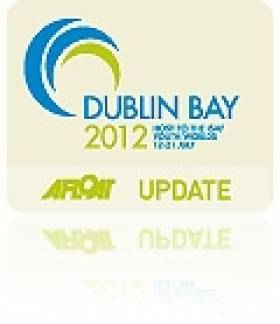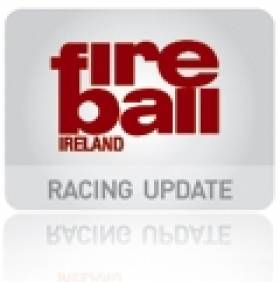Displaying items by tag: Worlds
Danes Deny O'Leary and Burrows Bronze in France
#STAR WORLDS – A 14th scored in today's final race has dashed hopes of an Irish medal at the Star World Championships in Hyeres on the South of France but Peter O'Leary and David Burrows will take great confidence from their consistent performance in some tricky conditions this week.
The world championships in Olympic year is regarded as one of the most accurate and final guages of performance before July's London Olympic regatta. The fourth place Irish finish is a significant improvement on their world championship record to date.
In a final race upheaval the British pairing of Iain Percy and Andrew Simpson who were the regatta leaders for most of the week finished second with Brazil's Robert Scheidt and Bruno Prada taking the overall honours. Denmark's Michael Hestbaek and Claus Olsen jumped from fifth position in the regatta to win bronze after a third place finish today.
O'Leary's and Burrows fourth place finish is one of few exceptional finishes for Irish crews at Olympic class World championships eclipsed in the Star class only by a Bronze medal finish by O'Leary's Royal Cork club mate Mark Mansfield and David O'Brien in 2000.
School of Dolphins Help Toppers on Their Way
Sailors arrived for day four of the 2011 Sovereign Ski Topper World Championship at the National Yacht Club in Dun Laoghaire to a flat sea and no wind writes Phil Harland. With increasing cloud cover there was no sea breeze forecast in the bay and so sailors prepared to wait on shore whilst the Race Committee went out on the water to check conditions.
Just before 11:00am the PRO decided to release the fleet from the shore to see what could be made of the light winds on the water. With the same efficiency as previous days all sailors were afloat within 30 minutes and making their way out of the harbour.
The Gold Fleet was the first to assemble on the start line and after an initial recall were clear away. Silver fleet were next but with light breeze and tide there was another general recall before they got away with George Haynes (GBR) port tacking the fleet.
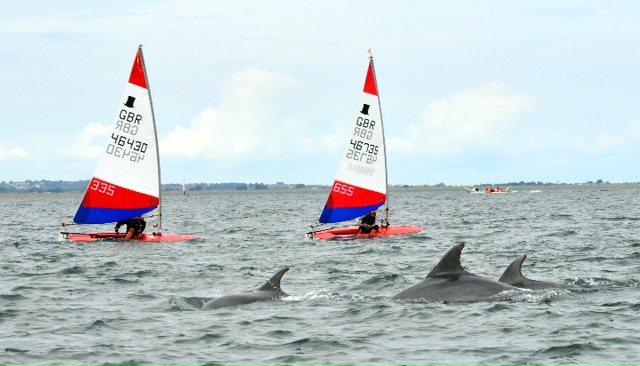
As Bronze went into sequence some newcomers joined in – a school of dolphins – all very friendly, swimming between the boats and jumping out of the water and swimming up the beat with the fleets. So keen were the dolphins to join in that the Bronze fleet start had to be delayed as they dolphins played around the boats on the line. Eventually Bronze fleet got away with a clean start - with the dolphins following them up the beat!
The wind conditions were proving particularly fickle for all the fleets with 45 degree wind shifts and pressure switching from one side of the course to the other leaving sailors who were doing well one minute dropping back down the fleet the next. Hunting pressure was the order of the day.
Fleet winners for the first race of the day were: Gold – Tim Brow (IRL); Silver – Olly Guess (GBR); Bronze – Peter Queally (IRL).
At 13:15 Gold fleet went into sequence for Race 2, but it was another general recall, followed by a clean start second time around. With the wind dropping further, but the chop remaining this was making sailing upwind very difficult. Silver fleet achieved a clean start followed by Bronze fleet, who started Race 2 as soon as they completed Race 1.
With the wind dying further, the Gold and Silver fleets both finished together – and a few dolphins re-appeared to join the fleets. Fleet winners for the second race of the day were: Gold – Matt Venables (GBR); Silver – Samantha Foster (GBR); Bronze – Niamh Doran (IRL).
The PRO tried to get in a third race, but with the wind now almost non-existent decided to send the fleets ashore in the hope of some better wind tomorrow.
With the challenging conditions, results were somewhat topsy-turvy across the fleets, but overnight leaders were: Gold – Matt Venables (GBR) and now with a 22 point lead over the nearest competitor; Silver – Joe Henderson (GBR); Bronze – Thomas Moore (IRL).
The winds forecast for the last day of the event look better and so the Race Committee decided that they would try and go for three races on Friday instead of the planned two, and so have instructed the fleets that will be launching an hour earlier than scheduled.
Irish Laser Radial sailors Philip Doran and Sophie Murphy tackled unfavourable variable light wind conditions in Day 4 of the ISAF Youth Worlds in Zadar, Croatia to produce four top ten performances, results that move Murphy up three places to eighth overall and Doran into 16th with two days of racing left.
Doran of Courtown Sailing Club and the National Yacht Club maximised yesterday's rest day and returned to the water this morning with 'a fresh mind'. He had his best day of the championships so far with two fifth places in the two races sailed today. Doran now moved up ten places from 26th.
Northern Irish sailor Sophie Murphy from Quoile YC and the Royal St. George YC had a similarly successful day. She placed 7th in her first race and although lying in 28th place rounding the first mark during her second race she worked hard and climbed the 41 boat fleet to finish in 6th place. Sophie now lies eighth and significantly the only Irish sailor in the top ten overall.
420 girls Emma Geary from Royal Cork Yacht Club and Niamh Connolly from Baltimore Sailing Club who favour heavier conditions had a tougher day placing 25th and 22nd respectively in their two races but their 25th placing is discarded leaving them in 22nd overall.
Maxime Mazard (FRA) continues to lead the Laser Radial Boys despite having an off day at the 41st ISAF Youth Sailing World Championship in Zadar, Croatia.
Mazard finished 24th in Race 8 before discarding his 38th place finish in Race 9. Mazard's 12 point lead from the third day has been reduced to five with Giovanni Coccoluto hot on his heels on 79 points.
But Coccoluto also struggled in breezier conditions in Zadar posting a 21st and 19th place finish. Israel's Oz Adam recorded an eighth place finish in Race 8 but finished 42nd in Race 9 and after discarding his DNF in Race 5 he slips down to third overall on 83 points.
?an-Luka Zelko (SLO) moved into contention for a medal today after claiming a bullet in Race 8 and coming tenth in Race 9 to sit fourth on 91 points. The Race 9 bullet went the way of ISAF Athlete Participation Programme sailor Ramon Gonzalez (PUR). The Puerto Rican sailor has 144 points to his name and is 17th overall.
In the Laser Radial Girls Poland's Paulina Czubachowska continues to lead the way on 50 points after nine races. But surprisingly she picked up her first bullet in Race 9 after posting an 18th place finish in Race 8. But the Polish sailor has shown consistency which has been key.
Manami Doi (JPN), in second, had a good day finishing 3-5 and moves into second place on 54 points. And Tiril Bue (NOR) had a better day following a bullet in Race 8 and a third place finish in Race 9. The Norwegian is third on 57 points.
The top of the 420 Girls is very tight with just six points separating the top three with three races remaining. Lara Vadlau and Tanja Frank (AUT) continue to lead the way after finishing with a bullet and third place today. But America's Morgan Kiss and Christina Lewis traded blows after the Austrians posted the same race results. But the Austrians are at the top of the leader board on 17 points with the Americans five points behind. Nikole Barnes and Agustina Barbuto trail the Austrians by six points in third.
Martin Lowy and Kim Andrade continued their dominance in the SL16 by winning their eighth consecutive race in a row. With eight points they have a gigantic 26 point lead with three races remaining in the championship. The Brazilians are in great form and with a huge lead the gold medal is almost theirs. The rest of the fleet will fight it out for the bronze and silver. Just nine points separate second and seventh place so it should be an interesting climax.
Spain's Carlos Robles and Florian Trittel have extended their lead in the 29er to 12 points after finishing fifth and fourth in today's racing. Australia's Josh Franklin and Lewis Brake had a consistent day finishing second in both races to move up to second overall. Antoine Screve and Max Agnese (USA) finished sixth and recorded a bullet in Race 9 to retain third place.The top of the RS:X Boys and Girls is looking interesting with just one point separating Veronica Fanciulli (ITA) and Siripon Kaewduang-Ngam (THA) in the Girls fleet. And four points split Cho Wonwoo (KOR) and Mateo Sanz (ESP) in the Boys.
Fanciulli finished 3-4 today to move onto 15 points and Kaewduang-Ngam came second in Race 7 before discarding her fifth place finish in Race 8. Naomi Cohen won Race 8 today and is second on 22 points. Agnieszka Bilska won the days other race and is fourth on 28 points.
And in the RS:X Boys Cho Wonwoo once again put in a consistent display out on the water. He came seventh in Race 7 and second in Race 8. He leads on 18 points. Sanz discarded his 13th place in Race 7 before bouncing back with a fourth in Race 8. The Spaniard is second on 22 points.
Sam Sills (GBR) won Race 7 today and is sixth overall on 55 points and the days other race win went to Pawel Tarnowski (POL) who is third on 30 points.
The 420 Boys are still out on the race course for their third race of the day.
Racing is set to commence at 12:00 local time tomorrow with two races scheduled in each fleet.
Laser Radial Girl Sophie Murphy is closest to Ireland's goal of sailing to a top ten result at this week's ISAF Youth Worlds in Croatia where conditions at the halfway stage continue to be light and tricky.
The event has added interest for Ireland as it will be staged next year on Dublin Bay, a venue alos know for its flukey winds. The Dublin organiser of the event Brian Craig is in Croatia to monitor progress there.
Murphy scored well in her first of the race of day three with a fourth after having a race win yesterday. She followed that with a 16th and 20th in the 41–strong fleet which leaves her in eleventh position overall going in to the rest day tomorrow.
Cork duo Emma Geary and Niamh Connolly in the 420 finished 17th and 21st today which sees them lying 17th overall.
Philip Doran from Courtown SC in the Laser Radial boys had a disappointing day fininshing 26th overall in the 49 boat fleet. Philip who is no stranger to large international competition (former 4.7 World Champion and the u17 Radial World Champion) remains optimistic and looking forward to a rest day tomorrow before the second half of the event recommences on Wednesday.
Doran Fourth at ISAF Youth Worlds
Wexford's Philip Doran lies fourth overall after an impressive opening two rounds at the 41st ISAF Youth Sailing World Championship in Zadar, Croatia.
Doran who is sailing in the Boys Laser Radial class has scored a 7 and 12 to be three points off third overall in his fifty boat fleet.
Sophie Murphy sailing in the Girls Laser Radial fleet is 19th after a single race in her fleet of 41.
The third Irish boat sailed by Emma Geary and Niamh Connolly, in the girls double handed 420 class, is 14th from 32 countries.
More from ISAF:
Boys 420 ISAF Athlete Participation Programme sailors Raul Rios and Fernando Monllor (PUR) ended the opening day of sailing at the top of the leader board.
The boys, who are benefitting from the coaching of World Youth Sailing Trust coach, Hugh Styles (GBR), ended Race 1 in eleventh place before claiming the bullet in Race 2.
And the Puerto Rican duo were delighted with their performance. Rios said, "It was pretty light and shifty and it was my first bullet. It is a great feeling, this is my third ISAF Youth Worlds and I've struggled a lot in the other two and this one we're really prepared."
And Monllor added, "It was a very nice. Sailing with Raul has been really good and a great experience, he is a really good sailor and having the opportunity to sail with him has been a great pleasure."
Tied on equal points with the Puerto Rican duo is Brazil's Ricardo Paranhos and Patrick Essle. The boys from Brazil finished 4-8 after the opening day of sailing. The Netherlands Floris van de Werkwn and Laurens van dev Werken are third on 13 points tied with Juan Manuel Garcia Rodriguez and Facundo Mario Olezza Bazan (ARG).
Japan's Daichi Mototsu and Yuki Hino won the opening race in Zadar but came 19th in Race 2 to end day one down in ninth overall.
The 420 Girls were the last off the water at 18:30 local time and only managed to fit in one race due to very light winds. Great Britain's Jessica Lavery and Georgina Morthesele won Race 1 followed by Austria's Lara Vadlau and Tanja Frank. Poland's Julia Rokosz and Joanna Szopinska finished third.
The 23-boat 29er fleet saw Carlos Robles and Florian Trittel (ESP) and Norway's Anders Kippenberg and Emil Mellbye claim the day's bullets. But it was the Spaniards who finished the day at the top of the leader board after finishing fourth in Race 2.
The Norwegians had a poor start finishing 17th in Race 1 but bounced back with the bullet in Race 2. They sit eighth.
Max Deckers and Annette Duetz (NED) came ninth and second in the two races today and are six points behind the Spanish 29er pair. America's Antoine Screve and Max Agnese finished 6-5 to end the opening day of sailing in Zadar in third place.
New Zealand's Tomer Simhony and Ellie Louise Copeland lead the SL16 following their bullet in Race 1 and third place finish in Race 2. Belgium's Phillip Hendrickx and Victor Klaas trail the Kiwis by five points. The Belgian sailors finished 4-5 today and Spain's Jordi Booth and Pau Dengra are in third after coming in second behind the Kiwis in Race 1 and finishing ninth in Race 2.
Brazil's Martin Lowy and Kim Andrade retired after the finish in Race 1, but the Brazilians bounced back with a bullet in Race 2 to end the day in ninth.
In the Laser Radial Boys, Maxime Mazard (FRA) had a fantastic day finishing with a third and second place to lead overall on five points. Terence Choo (SIN) came second in Race 1 and finished 13th in Race 2. One point behind in third place is Oz Adam (ISR) who went 12-4 today.
Mazard takes a ten point lead into the second day of sailing but with a lot of racing to come the Frenchman won't be getting carried away.
Only one race was possible in the Laser Radial Girls as the wind died throughout the day. The race win went to Hong Kong's Erica Hok Yan Leung. Sandy Fauthoux (FRA) came through in second ahead of Erika Reineke (USA).
The RS:X Boys and Girls were only able to fit one race in as well. Louis Giard (FRA) won the RS:X Boys race ahead of ISAF APP sailor Cho Wonwoo (KOR). Italy's Mattia Camboni (ITA) finished third.
And in the RS:X Girls Camboni's Italian team mate Veronica Fanciulli claimed the bullet. Agnieszka Bilksa (POL) came second and Israel's Naomi Cohen finished third.
Singapore 2010 Youth Olympic Games gold medallist Siripon Kaewduang – Ngam finished fourth and bronze medallist Audrey Yong (SIN) finished sixth.
As nearly 400 sailors descend on Zadar, Croatia for the 41st ISAF Youth World Championships, representatives of Dublin Bay, the 2012 ISAF Youth Worlds hosts will be on site in Croatia to learn all they can, having recently had a welcome nod of approval from ISAF's Fiona Kidd following her visit to Irish waters. Andi Robertson Reports.
"From what I saw things look to be very much ideal. It is new to us to have the competition spread across three different, adjoining clubs but I am sure that will work well. One yacht club is where the race management is centralised and it is all very manageable from there." Explained Kidd who chaired the ISAF Youth World Championships Sub Committee for eight years and has been involved with the championships since 1994.
"The launching facilities look good enough, boat parking is good everything there in terms of the physical plant all looked good. The accommodation is centralised and directly across the street from the boat park which the athletes really appreciate. It is excellent."
"But the success of these championships is very much down to volunteers and already we can see that there is a really great group of people. I had a tour of all the yacht clubs and they seemed really motivated, excited by the prospect and looking forward to it. I left feeling that it is all in very good hands."
"You have to remember that this event is really unique. It is likened to a mini Olympics and we emphasize that to host venues. At a class championships the sailors book their travel, accommodation bring their boats pay their money and go racing. This event I tell the organisers that from the minute they step off the plane until they go home you are responsible for around 500 sailors, you have to house them, feed them, provide top class racing and make sure they are always safe. Logistically it is big, and so the more volunteers to make it go smoothly, the better." Continues Kidd,
"On top of that it has to feel like something special, something different. So there is strict accreditation and access to the boat park, all modelled on the Olympics. It's important for the sailors it feels different and you don't have anyone wandering around the boat park. It has to feel special. They all have to work hard to qualify to be there, so it needs to feel different."
"The event has grown, now there are between 58 and 60 nations and more than ever the big nations like Australia, New Zealand, Italy, Spain, France, GBR send full teams and it has become the real launch pad for young sailors."
"It has been great to meet the organising teams for 2012, it really gives you a sense of who's doing what and I have a very good feeling about the event already."
"There will be a lot to learn this coming week in Zadar. For the first time ever we are having to split the 420's into flights and rotate them, and the accommodation is quite spread out there, and so we are hoping that it should all be made straightforward next year."
Often a successful ISAF Youth World Championships are the platform for a successful bid to host the ISAF Sailing World Championships, and Kidd confirms that a good Youth Worlds would set Irish sailing in good stead were they to look to hosting the Olympic classes ISAF Worlds in the future:
"Of the eight bids which were made for the ISAF World Championships four had hosted the ISAF Youth Worlds and all would be very capable of hosting the ISAF World Championships."
After the prizes were handed out for the Youth National Championships at the National Yacht Club tonight Olympic Team Manager James O'Callaghan named the Irish team for the 2011 ISAF Youth World Championships in Croatia in July. In the podcast below the team manager talks about the stand out performances of the weekend, and the strength of youth sailing in Ireland, and the prospect of a top finish in Croatia.
Newly crowned Radial champion Philip Doran of Courtown Sailing Club will represent Ireland in the Boys single-handed division in the Laser Radial dinghy and Sophie Murphy of Quoile YC will race the Laser in the Girls Division.
In the girl's double-handed dinghy class Emma Geary and Niamh Connolly (Royal Cork YC & Baltimore SC) will race the 420 dinghy. Ireland may yet be represented in the SL catamaran class if Alex Rumball and Ali Dix are successful at meeting the required standard this week at a French Eurocat SL16 qualification championship.
Afloat's weekend coverage of the Youth Sailing National Championships here.
Ten Irish Sign up for Torquay SB3 World Champs
But top ranked Irish performer Ben Duncan, who races from Howth Yacht Club is entered under his native New Zealand flag.
Seriously Bonkers (Martin Cuppage), Bad Kilcullen (Jerry Dowling) and Cathy MacAleavey's Bluebird are among Dun Laoghaire boats to enter so far. The full entry list is here.
The event will be hosted by the Royal Torbay Yacht Club, UK from 16 – 20 May 2011.
Representatives from fourteen nations will compete in the World Championships. The host nation field an entry of over seventy boats. Entries come from as far afield as Australia and South Africa. Ireland, France, The Netherlands, Portugal, Greece, Switzerland, Belgium, Germany, Ukraine and Russia will all be represented in Torquay in May.
The three Laser SB3 World Champions, Geoff Carveth (2008 Champion, Dun Laoghaire), Craig Burlton (2009 Champion, Cascais) and Jerry Hill (2010 Champion, Torbole) will all compete for the 2011 Championship title.
Carveth, Burlton and Hill are all British and so far the Laser SB3 World Championship has not been won by another nation. Will 2011 see the trophy slip from the Brits grip?
Australian sailing man of the moment, Nathan Outteridge, will compete with Laser SB3 Class President, Dave Cheyne in Torquay in May. Outteridge is twice 49er World Champion, current Moth World Champion and recent winner of the Audi King of Docklands and Audi Victoria Week in the Laser SB3. Fellow Australian Glenn Bourke returns to the class for the Championship.
South Africa’s Roger Hudson will compete in his fourth Laser SB3 World Championship and will no doubt be determined to better his current hatric of second places. Hudson has sailed each of the previous World Championships with a different helm; 2008 David Hudson (father), 2009 Taariq Jacobs and 2010 Iain Ainslie. It is yet to be announced which members of the Race Ahead Foundation will sail with Hudson in 2011.
In preparation for the World Championships, the Royal Torbay Yacht Club will host the Torbay Open, 30 April – 2 May and the Pre World Championship 12 – 13 May. These two events will provide a great opportunity for a number of keen teams from across Europe to travel to the UK and sail on the waters of Tor Bay prior to the World Championships.
“We’re really looking forward to hosting the event at the Club, I sail in the fleet so it’s great to be involved in delivering this event. We’re delighted with the size and quality of the entry list and look forward to extending the entry if necessary,” explained Event Organiser Adrian Peach.
The Laser SB3 Class is proud to be one of the most tightly restricted one design keelboat classes in the world with little variation from the builder’s final product permitted. With minimal maintenance, easy to trail and low campaign costs, the class thrives on its philosophy of providing inclusive, high intensity, great fun and easily attainable, quality racing for its members.
Further news and developments can be followed HERE.
Fireball title decided one day out
Among the Irish sailing entries, Neil Spain & Francis Rowan are the leading boat in 21st overall with Noel Butler & Seamus Moore in 26th. These two have kept most of their results in the twenties with each having a mid-teens result and a 30th each as well.
In 35th overall, Messrs Laverty & Butler have scored results mostly in the thirties but with one result in the twenties (27th) and two in the forties. Next up is Smyth/Bradley in 46th with a high of a 31st and a low of a DNF. Their results are consistently in the forties. Frank Miller & Marguerite O'Rourke have not had a good series by their standards and lie in 49th with the last Irish boat Hannah Showell & Martina Michels in 60th.
Other well known combinations are as follows; Derian & Andy Scott (18th), Tim Rush & Russ Clark (9th), Vince Horey/ Sam Brearey (11th) and Heather McFarlane & Chris Payne (17th).
Two races tomorrow (Fri) conclude the series but Howarth/Townend don't look as though they need to sail them both. Prize-giving is scheduled for tomorrow evening.
It has been a physically challenging series even on those days when the wind eased. The fleet has been launching at 11:45ish for a 12:30 start and getting ashore at around 16:30. Most evenings have seen the club environs empty earlyish. Burning the midnight oil in a social context has been the exception rather than the rule!!


























